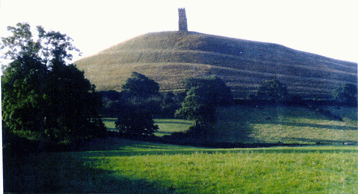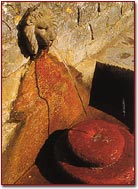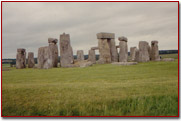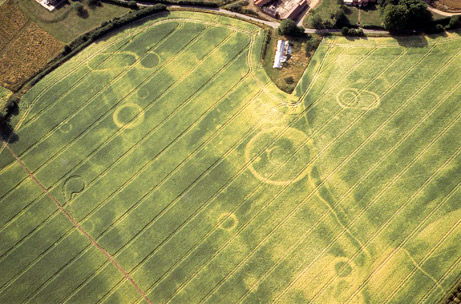"Avebury is a haunting place to see at all times and in all weathers, but most impressive of all on a still moonlit night, when it seems to be peopled with ghosts and the old church and cottages of the village seem quite new and insignificant..."
Sir John Betjeman, c. 1950
Avebury Stone Circle is in Wiltshire County, near Marlborough
Avebury is found where A4361 and A361 meet
Latitude: 51.428016N Longitude: 1.854678W
New Avebury to Stonehenge walk proposed - information in Avebury Village
Avebury from the Ancient History of Wiltshire, by Richard Colt Hoare, Vol II, Plate X1
John Aubrey (1625-97) ‘discovered’ the stones and earthworks of Avebury for the outside world, when fox-hunting on the Wiltshire downs. He later persuaded Charles II of Avebury’s grandeurs, and guided his king round the stones and up Silbury Hill. Aubrey is famous for his Brief Lives, witty and irreverent biographies of eminent seventeenth century thinkers.
Avebury stone circle

Druids in Ireland
Van Helmont, a physician of Brussels, writing on the state of European medicine at the beginning of the seventeenth century, remarked that the Irish nobility had each their domestic physicians who was appointed not because of his learning, but because of his ability to cure disorders. These doctors, he says, received their instruction chiefly from hereditary writings bequeathed to them by their ancestors, and employed as cures the production of their own country. "The Irish," he concludes, "are better managed in sickness than the Italians, who have a physician in every village." A large number of Irish medical manuscripts are still preserved, and the whole body of ancient medical writing in Irish is probably the largest in existence in any language. The Book of the O'Lees, preserved in the Royal Irish Academy, was written in 1443, partly in Latin, and partly in Irish. The Book of the O'Hickeys is even more venerable, having been translated into Irish in 1303 from the Latin work by Bernard Gordon.
In these and other books practically all the principal diseases and epidemics we are now acquainted with are described and specifics for their cure recommended. Bubonic plague, phthisis, alluded to as serg, or 'withering,' and described in Cormac's glossary as the disease of 'those without fat,' erysipelas, or the teine-buirr, the 'fire of swelling,' and tuthle or cancer, are all enumerated, and mention is also made of palsy and ague.
Indeed, the training of a surgeon in ancient Ireland; seems to have been a matter of prolonged and arduous application.
That the medical system of ancient Ireland was of Druidic origin is undoubted, as was that of Wales, and its continued practice must have served to keep the Secret Tradition alive, as we may be sure the one could not very well have existed without a modicum of the other.
-Lewis Spence, Chapter XI. Druidism and the Secret Tradition in Ireland, THE MYSTERIES OF BRITAIN
Research
THE CULT OF SACRED TREES
The things said of sacred waters can also be said of sacred trees among the Celts; and, in the case of sacred trees, more may be added about the Druids and their relation to the Fairy-Faith, for it is well known that the Druids held the oak and its mistletoe in great religious veneration, and it is generally thought that most of the famous Druid schools were in the midst of sacred oak-groves or forests. Pliny has recorded that ‘the Druids, for so they call their magicians, have nothing which they hold more sacred than the mistletoe and the tree on which it grows, provided only it be an oak (robur). But apart from that, they select groves of oak, and they perform no sacred rite without leaves from that tree, so that the Druids may be regarded as even deriving from it their name interpreted as Greek’ (a disputed point among modern philologists). Likewise of the Druids, Maximus Tyrius states that the image of their chief god, considered by him to correspond to Zeus, was a lofty oak tree; and Strabo says that the principal place of assembly for the Galatians, a Celtic people of Asia Minor, was the Sacred Oak-grove.
Just as the cult of fountains was absorbed by Christianity, so was the cult of trees. Concerning this, Canon Mahé writes:—‘One sees sometimes, in the country and in gardens, trees wherein, by trimming and bending together the branches, have been formed niches of verdure, in which have been placed crosses or images of certain saints. This usage is not confined to the Morbihan. Our Lady of the Oak, in Anjou, and Our Lady of the Oak, near Orthe, in Maine, are places famous for pilgrimage. In this last province, says a historian, “One sees at various cross-roads the most beautiful rustic oaks decorated with figures of saints. There are seen there, in five or six villages, chapels of oaks, with whole trunks of that tree enshrined in the wall, beside the altar. Such among others is that famous chapel of Our Lady of the Oak, near the forge of Orthe, whose celebrity attracts daily, from five to six leagues about, a very great gathering of people.”’
The Fairy-Faith in Celtic Countries, by W. Y. Evans Wentz
How Stuff Works traditional Stonehenge, one of some 80 British prehistoric ruins
Rosslyn Chapel, Roslin, Midlothian, Scotland
Rosslyn Chapel was founded in 1446 by Sir William St Clair, third and last St Clair Prince of Orkney.

POWER SITES - TOR BURR

Tor Burr is an ancient name for Glastonbury Tor, legendary birthplace of Christianity when it arrived in Britain.
Legend goes that the first British church was built there at Joseph's behest to house the Holy Grail, 30 or so years after the death of Jesus. Through the legend of the Holy Grail, we learn of an early Christian link between young Jesus and His uncle Joseph of Arimathea, who visited the Isle of Avalon during the 'lost years' of Jesus. It is generally held that the first Christian church above ground was built at Glastonbury by Joseph.* Glastonbury is said to be the centre of several ley lines. see Early Heraldry for Christ heraldry
 The story of the Grail continues at Glastonbury Abbey when the sacred cup was moved to the Chalice Well. During the Middle Ages many of the faithful traveled to the Abbey on a pilgrimage to the site believed the resting place of the Holy Grail, King Arthur and Queen Guinevere. Carriages entered the grounds through a great wooden door over which hung the jaw bone of a giant blue whale. The blue whale, largest known animal mentioned in Genesis, was a symbol of Christ in early Christianity. The Holy Thorn, or Glastonbury Thorn, blooms twice each year in the Abbey gardens. The original tree was transplanted from the Mount of Olives above Jerusalem, or as traditions says, it is the tree believed to have sprung from Joseph's staff, which he planted on the hillside.
The story of the Grail continues at Glastonbury Abbey when the sacred cup was moved to the Chalice Well. During the Middle Ages many of the faithful traveled to the Abbey on a pilgrimage to the site believed the resting place of the Holy Grail, King Arthur and Queen Guinevere. Carriages entered the grounds through a great wooden door over which hung the jaw bone of a giant blue whale. The blue whale, largest known animal mentioned in Genesis, was a symbol of Christ in early Christianity. The Holy Thorn, or Glastonbury Thorn, blooms twice each year in the Abbey gardens. The original tree was transplanted from the Mount of Olives above Jerusalem, or as traditions says, it is the tree believed to have sprung from Joseph's staff, which he planted on the hillside.
 Glastonbury Festivals and Pictures
Glastonbury Festivals and Pictures
Every year the Glastonbury Festival takes place in the nearby village of Pilton.
The official Glastonbury Festival@GlastoFest, Worthy Farm, Pilton
http://www.glastonburyfestivals.co.uk

The King Arthur Cross
and Abbots of Glastonbury
The King Arthur Cross
The leaden plate in the form of a Cross was found in King Arthur’s grave
at Glastonbury Abbey in the reign of King Henry II.
The inscription reads: Hic jacet sepultus inclytus Rex Arthurus in Insula Avalonia ["Here lies interred in the Isle of Avalon the renowned King Arthur."]

Are Knights Templar Guardians of The Holy Grail?
Vatican declares Knights Templar innocent for 700th anniversary
The persecution of the Templars began on Friday, 13 October 1307, when the medieval organisation was unjustly attacked and driven underground. A letter to the Pope from living descendents of the Templars appeared in the press in 2004. "We shall witness the 700th anniversary of the persecution of our order on 13th October 2007," the letter said. "It would be just and fitting for the Vatican to acknowledge our grievance in advance of this day of mourning."
The mysteries of the Order of the Knights Templar could soon be laid bare after the Vatican announced the release of a crucial document which has not been seen for almost 700 years.
Characters in the Legend of Arthur - Mary Magdalene and Joseph of Arimathea
Traditional European teaching, passed down through the centuries, places Magdalene at the foot of the cross with Jesus, catching drops of blood as they fell during the duration of the crucifixion. The receptacle she held was the Holy Grail, the bowl or cup of Jesus at the Last Supper.
After the Paraclete descended for Mary and the apostles in the upper room, she and several others, including Joseph of Arimathea, left the Middle East and traveled to France in "a boat with no oars". This description suggests they left from Egypt in a papyrus boat light enough to move through traffic lanes formed by the water currents.
One legend teaches King Arthur was a descendant of Joseph of Arimathea, an uncle of Jesus and one of the powerful Sanhedrin not called to the early morning "trial" of Jesus. The Sanhedrin was the legal supreme court of the Jewish people, but the "shady" process and questioning of Jesus was a blatant manipulation of the law [no quorum present] that made it impossible to reach a just verdict. The mock trial is recorded by all four Canonical gospels of the New Testament, although John's Gospel does not explicitly mention a Sanhedrin trial.
Joseph of Arimathea was said, not only to have come to Britain, but to have settled at Glastonbury where he was given land by King Arviragus. A local tradition, perhaps not older than the nineteenth century, says he buried the cup of the Last Supper above the spring in Glastonbury and hence the water has a red tinge.

Ancient healing waters flow into a well-manicured garden setting. Nearby lies Chalice Well [with chalybeate, the iron in it stains the rocks] all round a rusty red – giving rise to associations with the pure male principle, the Grail and Holy Blood.

The well-head is lined with massive stones of unknown origin, and a fine nineteenth-century cover with the symbol of the vesica piscis adorns its rim. The vesica piscis, a symbol of the overlapping worlds of which Glastonbury is a nexus-point.
"Sir Paul McCartney has written that he found inspiration for his recent symphonic poem, "Standing Stone," on his many trips to Scotland.
Maltwood writes in her celestial tour of the UK, GLASTONBURY’S TEMPLE OF THE STARS, that the sympathetic connection, between the Air Sign Aquarius the Water Bearer [February] and The Chalice Well healing waters,
has been recorded from ancient times. "The Water Bearer effigy of Glastonbury’s Isle of Avalon resembles a Phoenix with outstretched wings, turning its head to reach the life-giving waters of Chalice Well Blood Spring; for the Druid’s well forms the Urn of this Aquarius and has always been associated with the Holy Grail. That being so, the astronomical point of view throws considerable light on it, for the Aquarius Cup received the rays of the sun at the Winter Solstice, and those of the moon at the Summer Solstice, about 3000 B.C."
-K. E. Maltwood
GLASTONBURY’S TEMPLE OF THE STARS
Personal note: When I attended a ceremony at the Chalice Well, during the week of the Autumn Equinox, people visiting the well and grounds were allowed to wash their face and hands in the waters that flow from the ancient well. The immediate feeling of serenity and renewal is similar to the power we experience during the celebrations at Pentecost.
 While England's famous Stonehenge records the trajectory of the sun on Midsummer Day (June 24th) the nearly fifty monolithic stones at Callanish may have, for some 4,000 years, traced the path of the moon.
Isle of Lewis in the Western Isles, off the NW coast of the Scottish Highlands.
While England's famous Stonehenge records the trajectory of the sun on Midsummer Day (June 24th) the nearly fifty monolithic stones at Callanish may have, for some 4,000 years, traced the path of the moon.
Isle of Lewis in the Western Isles, off the NW coast of the Scottish Highlands.
For more information call 011 44 131 668 8800."
Source: The New Yorker, March 23, 1998. Because the trip Robert Hunter embarked on, during his 1970 - 1973 Sol changes, included visiting The Beatles, one ponders the range of discussion and frequencies covered by these exploratory musicians at tea time. The Dead are said to have to contributed to a collection of songs recorded at the Glastonbury Festival in this time window (along with Neil Young?) as well, though this LP is part of a private collector sound library.
Camlann Medieval Village, a living-history-museum project portraying rural England in the year 1376
Camlan - Latitude: 52.689046N Longitude: 3.695451W
Country: Wales, County: Gwynedd
MERLIN, King Arthur’s Magician and Counselor
Welsh: Myrddin, Latin: Merlinus
In many ways, Merlin is considered the architect of King Arthur's reign. Several important historical and magical sites are attributed to the life of Merlin.
Merlin’s ghost is said to haunt Merlin’s Cave** at Tintagel, Cornwall. Nearby, from 1870 a lead mine was worked for a short time close to this site at land's end. The first excavations were undertaken by Ralegh Radford in the 1930s; he suggested that Tintagel was in fact a Celtic monastery and not an "Arthurian" site, yet the theory is considered "educated speculation". The present-day ruins of Tintagel are situated on a rocky peninsula that overlooks a part of the Atlantic Ocean, known as the Celtic Sea. Nearby, 50° 31' 1.96" N, 4° 27' 46.12" W, is the site of The Hurlers (stone circles), first noted by historian John Norden in 1584.
Merlin’s Spring is located at Barenton in Brittany, but these pilgrimages were stopped by the Vatican in 1853.

POWER SITES - AIR PHOTOGRAPHY - NEW CIRCLES IN THE UK

photographs taken from airplane over ancient site in Britain
June 15, 2009
POWER SITES - CIRCLES FROM THE AIR
German "Stonehenge" marks oldest observatory, part 2
Madhusree Mukerjee writes from Frankfurt, Germany.
In Focus
December 08, 2003
A vast, shadowy circle sits in a flat wheat field near Goseck, Germany. No, it is not a pattern made by tipsy graduate students. The circle represents the remains of the world's oldest observatory, dating back 7,000 years. Coupled with an etched disk recovered last year, the observatory suggests that Neolithic and Bronze Age people measured the heavens far earlier and more accurately than scientists had imagined.
Archaeologists reported the Goseck circle's identity and age this past August. First spotted by airplane, the circle is 75 meters wide. Originally, it consisted of four concentric circles--a mound, a ditch and two wooden palisades about the height of a person--in which stood three sets of gates facing southeast, southwest and north, respectively. On the winter solstice, someone at the center of the circles would see the sun rise and set through the southern gates.
Although aerial surveys have demarcated 200-odd similar circles scattered across Europe, the Goseck structure is the oldest and best preserved of the 20 excavated thus far, and it is the first circle whose function is evident. Though called the German Stonehenge, it precedes Stonehenge by at least two millennia. The linear designs on pottery shards found within the compound suggest that the observatory was built in 4900 B.C.
Perhaps the observatory's most curious aspect is that the roughly 100-degree span between the solstice gates corresponds with an angle on a bronze disk unearthed on a hilltop 25 kilometers away, near the town of Nebra. The Nebra disk, measuring 32 centimeters in diameter, dates from 1600 B.C. and is the oldest realistic representation of the cosmos yet found. It depicts a crescent moon, a circle that was probably the full moon, a cluster of seven stars interpreted to represent the Pleiades, scattered other stars and three arcs, all picked out in gold leaf from a background rendered violet-blue--apparently by applying rotten eggs.
The two opposing arcs, which run along the rim, are 82.5 degrees long and mark the sun's positions at sunrise and sunset. The lowest points of the two arcs are 97.5 degrees apart, signifying sunrise and sunset on the winter solstice in central Germany at the time. Likewise, the uppermost points mark sunrise and sunset on the summer solstice. The sun's position at solstice has shifted slightly over the past millennia, notes Wolfhard Schlosser of the Ruhr University in Bochum, so that the angle between sunrise and sunset is now slightly farther apart than when the Nebra disk and the Goseck circle were made (by 1.6 and 2.8 degrees, respectively).
Nearby excavations of wood-and-clay houses have turned up a variety of grains and evidence of domesticated goats, sheep, pigs and cows. Farmers reached this part of the world some 500 years before they built the solar observatory. Although these earliest Neolithic agriculturists most likely measured only the sun's movements, over millennia they came to quantify the lunar cycle and the positions of constellations. The Pleiades, which depart the northern sky in spring and reappear in the fall, still mark crop cycles for many farmers around the world. The Nebra disk may have been a ritual object or, more likely--given its precision--a calculational tool used with observations at Goseck or a similar site to determine planting and harvest times.
The third arc on the disk, believes Francois Bertemes of the University of Halle-Wittenberg, is the stuff of legend. The ancients did not understand how the sun could set in the west and end up in the east the next morning. Representations of a disk in a ship, from Bronze Age Egypt and Scandinavia, reveal an age-old belief that a ship carried the sun across the night sky. The Nebra disk is the first evidence of such a faith in central Europe. That the land-bound cultivators knew of ships is no surprise: Bertemes points out that travelers spread the latest in Bronze Age technology as well as mythology.
TO AN OBSERVER standing at the center of the circle, the sun rises and sets through the southern gates (above, at top) on the winter solstice; the northern gate's function is unknown.
The third gate at Goseck remains mysterious, however: it points north, but not quite. It may have nothing to do with astronomy, for the compound was more than a solar station. In addition to pottery shards and arrowheads within, excavators found the decapitated skulls of oxen, apparently displayed on poles, and parts of two human skeletons. The human bones were cleaned of flesh before being buried. Similar skeletons--several with cut marks or with arrowheads in their necks--have turned up in other circles, but archaeologists cannot agree on whether they attest to human sacrifices or to uncommonly gory funeral rites. Nevertheless, such ceremonies anoint the site as a temple, Bertemes notes--and show that science was inextricably entangled with superstition since Neolithic times.
ScientificAmerican.com
Found: temple sacred for
3,000 years
The astonishing past: Stone Age site 30
Times the size of Stonehenge is
discovered as Smith prepares to
Repatriate bones of Aborigines
By David Keys, Archaeology Correspondent
26 November 2000
Archaeologists have discovered a mysterious 4,700-year-old temple that is the largest Stone Age structure ever found in Western Europe. More than a half a mile across and covering 85 acres, the site in mid-Wales is 30 times the size of Stonehenge.
A six-year research programme has revealed that the vast, egg-shaped religious complex consisted of 1,400 obelisks, each towering up to 23ft into the air. Made of oak, they were arranged as an oval with a perimeter of one-and-a-half miles. At its western end, archaeologists have discovered the site of the temple’s main entrance – flanked by 6ft diameter timbers that may have stood 3pft tall.
Despite its vast size, the site is baffling archaeologists. They are certain that it had a religious function – but what was being worshipped or venerated remains a mystery.
The focal point appears to have been a natural spring – and possibly some sort of shrine. The complex may have been built on such a grand scale to include a second possible shrine 500 yards north-west of the spring and an area of further ritual activity about 200 yards to the north-east. The main entrance is oriented towards sunset on the summer solstice – the point at which the sun on the summer solstice – the point at which the sun disappears after the longest day of the year.
Detailed examination has revealed that the enclosed area was kept clear for almost 3,000 years. Outside the oval, archaeologists have found a normal level of flint and other prehistoric finds. Inside there have been almost no finds at all.
"They must have kept it extraordinarily clean" said Dr. Alex Gibson, an archaeologist who has spent much of the past six years investigating the site for Clwyd-Powys Archaeological Trust. It remained untouched by normal – secular – human activity from its construction in 2700BC, through the late Neolithic and the whole of both the Bronze Age and the Iron Age, which ended after the Roman invasion of AD43.
The absence of debris of human activity from the earlier parts of the Neolithic era suggest the area may have been taboo for even longer – possibly from 4000BC.
After the arrangement of 1,400 oak obelisks was constructed – just before the time that most of Stonehenge was built – it is likely that ordinary people were not just barred from the site, as they probably had been for generations, but were also prevented from seeing inside it. Archaeologists believe planks were used to close the gaps between the obelisks for at least the bottom third of their height.
The temple was almost certainly kept exclusively for the use of the priesthood – probably; shamans whose function was to maintain spiritual contact with ancestors and deities.
However, when the Roman invaders arrived, its very sanctity seems to have made it a target. For, in common with many other native British sacred sited – including Stonehenge – the place appears to have been deliberately violated. The Romans seem to have chosen to insult local sensibilities by building first a marching camp on one part of the site and then a permanent fort on another.
The site – at Hindwell, three miles east of New Radnor in Powys – is being seen as one of the most important inn Europe. "We were bowled over by the sheer scale of the structure – and the fact that it appears to have remained sacred for thousands of years," Dr. Gibson said.
* Keltic tradition held that 'the Salmon of Knowledge was the oldest living thing, whoso ate of him would enjoy all the wisdom of the ages'. He was said to haunt the Severn River. Only three miles up a tributary of the Severn stands Glastonbury, buttressed by its famous Wearyall Hill upon which Joseph of Arimathea landed. This hill for generations has been pointed out to visitors as 'the burial place of a gigantic sacred salmon', part of it being called Fisher's Hill.
K. E. Maltwood
The Enchantments of Britain
Taliesin is the Welsh wizard bard who began life as Gwion Bach, a servant to the witch Cardiwen. One day she was mixing a great concoction which, after a year’s boiling, would yield three blessed drops. Whoever swallowed these drops would know all the secrets of the past, present and future. Helping to tend the fire beneath the cauldron, Gwion Bach’s hand was scorched by some of the dripping liquid, and before Cardiwen could stop him, he had sucked his finger, and received the knowledge. Enraged, the witch chased the boy, finally catching him after numerous transformations. Thrown into the sea at last, he was caught in a fish trap, and called Taliesin by those who saw him, because of his radiant brow. He went on to become one of the most accomplished wizards and sages in the kingdom.
** The wizard is variously said to be buried at Drumelzier in Scotland, under Merlin’s Mount in the grounds of Marlborough College, at Mynydd Dryddin and in Merlin’s Hill Cave in Carmarthen.
your home is your temple your home is the reflection of your soul
